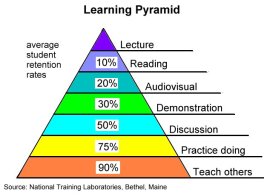You’ll be aware of my pessimism lately with regards to many things in education, so here’s another to add to the list. Anything that is in a pyramid should be treated with caution! There, I’ve said it. The fact that something is represented as a pyramid seems to give it a legitimacy; “it must be real, the pyramid said so”. Unfortunately, I’m not so convinced and in my humble opinion, the only place we should see pyramids is in Egypt…and Mexico…
I must admit that I’ve been as guilty as the next person of falling foul to things in pyramids. I like diagrams to explain concepts and I like being told that my problems will be solved by following a new strategy (even though I don’t actually have a problem to solve). Let’s look at some pyramids that we might want to be wary of:
1. The Learning Pyramid:

This bad boy has been used in many a training session advocating active learning. “You only retain 5% of what you hear!” Scientific looking, clear information and in some ways believable information, but actually this is just one unsubstantiated mess.
The so called ‘learning pyramid’ actually turns out to be a cone of learning which was created by a chap called Edgar Dale in the 50’s. Dale’s Cone of Experience is a visual model that is composed of eleven (11) stages starting from concrete experiences at the bottom of the cone then it becomes more abstract as it reaches the peak of the cone. Also, according to Dale, the arrangement in the cone is not based on its difficulty but rather based on abstraction and on the number of senses involved. The cone was made more appealing and nicely rounded off percentages were added by Mobil oil company in the 60’s with no scientific research for them. Essentially, it’s impossible to conduct a study to determine the effectiveness of each of these and compare and is therefore is a load of tosh.
2. The Hybrid Pyramid:

This is my favourite one – the hybrid pyramid of learning styles and the learning pyramid combined! Let’s hope you’re not an auditory learner, otherwise you’re stuffed according to this. If you haven’t read my recent post on learning styles, then check it out. If you have, then you’ll realise how nonsensical this thing is.
3. Maslow’s Hierarchy of needs:

Another creation from the mid-20th Century. Basically Maslow implies that we must meet all levels of the hierarchy in order to achieve what he coins as ‘self-actualisation’. Whilst this sounds very believable, it surely can’t be true. In fact, the differences that exist between cultures and age groups provide no support to his hierarchy. Once again, appealing, yet no scientific base for the research but instead research based upon his own interpretations of ‘distinguished individuals’ (typically white upper/middle class males). Ironically, this is heralded by humanists – yet its linear, broad brush approach to achieving ‘self-actualisation’ seems rather behaviourist in nature.
4. Blooms Taxonomy:

Whilst the better of the ‘pyramids of doom’, this is yet another one that is style over substance. The taxonomy (which according to some isn’t even a real taxonomy), assumes that all learning will take place in a linear fashion from remembering to creation, omitting both the psychomotor and affective domain of learning. We’ve all been told to make our learning objectives move from low-to high order using Bloom haven’t we?
This brilliant 99 second review of Bloom’s taxonomy highlights some key problems with the validity and reliability of the model. Moreover, Marzano informs us that ‘the hierarchical structure of Bloom’s Taxonomy simply [does] not hold together well from logical or empirical perspectives’.
In conclusion, if you want to use any of the above in your planning and delivery then fine, but don’t restrict yourself to them, and certainly don’t be a snake oil salesman.

Well said, though through my research I’ve had to construct some diagrams as it helps plot and represent relationship complexities in a clear fashion.
Thanks, H. Yes they can definitely be useful to show abstract concepts.
Reblogged this on The Echo Chamber.
Pointing that sacred cows of ed research should be closely examined and in the same post, Marzano is not critiqued. Not knocking Marzano or the ultimate outcomes, just that close examination does point out how some assertions are not backed up with solid evidence that would be critically accepted by most scientists.
Fair point. Thanks for the comment.
Reblogged this on Always Wanted to Fly and commented:
Awesome piece
Thank you
I have recently seen articles (links from LinkedIn) claiming to ‘Maslow’ everything from sales techniques to management and leadership. Bloom’s taxonomy had a single purpose and putting anything (including Maslow) into a pyramid doesn’t give it authority (I think Maslow never used a pyramid, by the way).